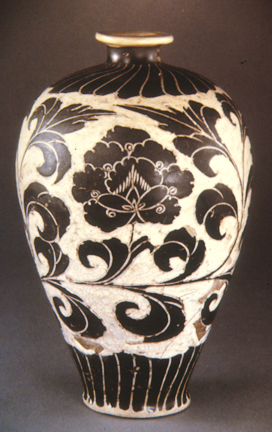
Song Dynasty Meiping, Cizhou Ware, Stoneware
China, 1175-1225, 11.6" heigh
ART 198 - HISTORY OF WORLD CERAMICS
| In addition to the austere and restrained styles more often associated with the Song Dynasty, other, more exuberant styles were created as well. One notable example is Cizhou (Tzu'chou) ware, made during what is called the Northern Song in the area near where the Yellow River empties into the Yellow Sea. The designs on Cizhou ware are bold and striking, and involve the use of sgraffito. A stoneware clay body was used, which was brown in color. Onto this, a white slip was first painted, then a black slip. Next the potter would carve the designs through the black slip to reveal the white, and then a clear glaze would be applied, which, after firing, would allow the black and white design to show. This example is quite representative, and the bold, floral design on peonies and leaves is often seen. The peony motif is often seen in Chinese art, and is considered a symbol of royalty since the name of the peony in Chinese is a homophone for the word for wealth and rank. Homophones are two words that sound the same, but have different meanings. An example in English would be the words: flower and flour, they sound the same, but have different meanings. This particular shape is called a meiping (plum blossom) vase. Its graceful proportions begin with a flat base, that immediately narrows slightly, then swells confidently to the shoulder before narrowing in to a rather small neck. The purpose of such a small-necked vase was to display a single spray or branch from a flowering plum tree. Many fruit trees flower before they leaf out in the spring, and the plum tree presents spectacular flowers against a bare branch. Cizhou ware was produced primarily for use by ordinary people as opposed to use by royalty. | Song Dynasty Meiping, Cizhou Ware, Stoneware China, 1175-1225, 11.6" heigh |
|
|